Black banded leporinus - Leporinus fasciatus
Scientific name: Leporinus fasciatus
Common name: Black banded leporinus
Family: Anostomidae
Usual size in fish tanks: 24 - 30 cm (9.45 - 11.81 inch)
014
Recommended pH range: 5.5 - 7.5
Recommended water hardness: 4 - 18°N (71.43 - 321.43ppm)
0°C 32°F30°C 86°F
Recommended temperature range: 23 - 29 °C (73.4 - 84.2°F)
The way how these fish reproduce: Spawning
Where the species comes from: South America
Temperament to its own species: aggressive/territorial
Temperament toward other fish species: aggressive/territorial
Usual place in the tank: Bottom levels
Origin
The Black-Banded Leporinus is native to various rivers in Central and South America, including the Amazon River, the Orinoco River, and the Rio de la Plata. Its coloration may vary depending on the specific habitat.
Lifespan
With proper care, the Black-Banded Leporinus (Leporinus fasciatus) can live for over 5 years.
Description
This fish is not ideal for beginners. The Black-Banded Leporinus can nip at other fish’s fins, is known to jump out of the tank, and can grow up to 8-12 inches (~20 to 30cm) in length. It has teeth, so handle with care. The bands on its body change as it ages. As a juvenile, it has 5 bands. By the time it is one year old, the first band splits into two, and every six months, another band will split. By three years old, it will have developed 10 bands.
While aquarium décor is optional, adding driftwood or bogwood can enhance the tank's appearance. Plants can be added, but they may be damaged by this fish, so proceed with caution.
The water must be well-oxygenated, so position filter outlets towards the surface. Use a secure lid, as the Black-Banded Leporinus may jump out of the tank. Maintain high water quality by performing regular water changes, cleaning décor, and promptly removing uneaten food to prevent decay and water contamination.
These fish are best kept in groups, but a small group may lead to squabbles. In smaller tanks, it’s better to keep just one specimen to avoid conflicts.
Food
The Black-Banded Leporinus primarily eats plant-based foods. It will take algae flakes and wafers but prefers fresh vegetables like cooked peas or lettuce. While it mainly eats plants, it may also accept bloodworms and brine shrimp. Avoid feeding meaty foods as they can be difficult to digest. Although they are primarily herbivores, they may prey on smaller tank mates if kept with them.
Sexing
Determining the sex of Black-Banded Leporinus is challenging until they reach maturity. At this stage, females tend to be larger and have a rounder body shape compared to males.
Breeding
Little is known about the breeding habits of Black-Banded Leporinus. They rarely breed in captivity, but they are known to be egg layers.
Pictures
Images courtesy of aqua-fish.net and jjphoto.dk.
Q&A
On March 23, 2011, the following question and answer were added here as part of merging aqua-fish.net/answers with related pages.
What size tank do you need for a Leporinus?
Answer: Leporinus can grow up to 12 inches (30 cm) long. It is recommended to have a tank that is at least 48 inches (122 cm) in length. Be sure to use a lid, as these fish can jump out of tanks with open tops.
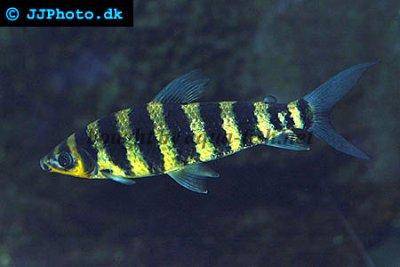



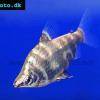 Abramites
Abramites 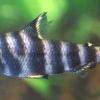 Marbled
Marbled 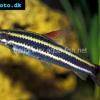 Striped
Striped 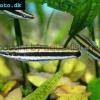 Goldstripe
Goldstripe  Headstander
Headstander